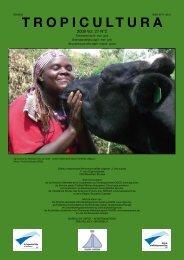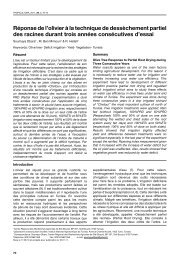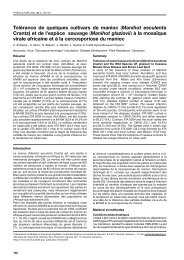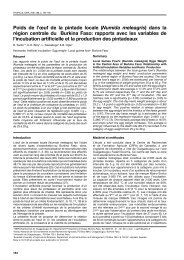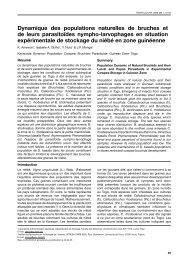Fascicule entier - Tropicultura
Fascicule entier - Tropicultura
Fascicule entier - Tropicultura
You also want an ePaper? Increase the reach of your titles
YUMPU automatically turns print PDFs into web optimized ePapers that Google loves.
Results and discussion<br />
Plants are good sources for the discovery of<br />
pharmaceutical compounds and medicines. Natural<br />
products could be potential drugs for humans or<br />
livestock species, and also these products and their<br />
analogues can act as intermediates for synthesis<br />
of useful drugs. Bioassay directed isolation and<br />
synthesis of analogues have long been appreciated as<br />
the effective approach for development of new plant<br />
derived compounds.<br />
Levels of secondary metabolites are both<br />
environmentally induced as well as genetically<br />
controlled. The secondary metabolites are also called<br />
as plant defensive compounds since these have been<br />
evolved to deter pathogens or herbivores such as insects<br />
and mammals. The plants growing on low nutrient<br />
soil or in harsh conditions are often more dependent<br />
on evolved chemical defences. The Mongolian plants<br />
grow under harsh conditions of extremely low and high<br />
temperatures and thus could contain PSMs with a wide<br />
range of interesting activities.<br />
The common names of plants, their distribution in<br />
Mongolia and reported medicinal uses are listed in<br />
table 1. This table also contains information on farmers’<br />
opinion on the palatability of the leaves by livestock<br />
and on their nutritional value. The leaves in particularly<br />
of Artemisia frigida and Taraxacum officinale are highly<br />
palatable by animals. The leaves studies are found<br />
in different regions of Mongolia and are considered<br />
to posses wide medicinal values, ranging from<br />
antimicrobial and anthelminthics to kidney- and liverstimulating<br />
effects (Table 1).<br />
The crude protein (CP) content of the leaves varied from<br />
6.3 to 24.5%. The CP content was lowest (3.3%) in root<br />
sample of Bergenia crassifolia (Table 2). The leaves of A.<br />
frigida and T. officinale were reported by farmers to have<br />
high nutritional value. The CP content of these leaves<br />
considered good for livestock had high CP values (15.6<br />
and 24.6% respectively); although mature leaves of A.<br />
frigida have a lower CP content (9.0%).<br />
Tannins are polyphenolic compounds and have a wide<br />
range of effects varying from decreasing availability<br />
of proteins and other nutrients including amino acids<br />
and minerals to protecting ruminants from bloat,<br />
enhancing rumen bypass protein, enhancing meat<br />
quality and decreasing helminth infestation. Tannin<br />
level and activity was very high in B. crassifolia roots<br />
and leaves of B. crassifolia, Vaccinium vitisidaea<br />
and Rheum undulatum. A moderate tannin activity<br />
(33.4% increase in gas on addition of PEG) was<br />
present in Thymus gobicus. Tannins are also known<br />
to have antimicrobial, anthelmintic, antimutagenic,<br />
antiinflammatory and antioxidant properties. A<br />
TROPICULTURA<br />
number of tannin-rich tree leaves and browses have<br />
been evaluated and found to be effective in reducing<br />
faecal egg worm and enhancing livestock productivity<br />
(13). Parasitism by gastrointestinal nematodes is one<br />
of the major constraints on livestock production,<br />
especially when the nutritional status of the animals<br />
is poor. Subclinical infections of gastrointestinal<br />
nematodes decrease feed intake, body-weight gain,<br />
and milk and wool production. In subtropical and<br />
tropical areas of the world where the animals are on<br />
low quality feeds and have poor nutritional status,<br />
mortality and morbidity due to nematode infection<br />
are widespread. There is a growing awareness that<br />
chemical anthelmintic treatment, on its own, may not<br />
provide a long term strategy for managing parasites<br />
in grazing animals. The widespread development and<br />
prevalence of resistant strains of nematode parasites<br />
and public concern over drug residues excreted in<br />
animal products have stimulated efforts to identify<br />
and use plant-based anthelmintic compounds;<br />
tannin-containing plants and tannins could potentially<br />
be natural anthelmintics.<br />
Among the above-mentioned four plants identified<br />
as containing substantial amounts of tannins, only T.<br />
gobicus has been used by farmers as an anthelmintic<br />
to dispel intestinal worms. The presence of etheric oil<br />
compounds such as thymine, eugenol and carvacrol in<br />
this plant could also be responsible for its anthelmintic<br />
effects. The other three tannin-rich plants B. crassifolia,<br />
Vaccinium vitisidaea and Rheum undulatum also hold<br />
potential for reducing the intestinal worm load in<br />
livestock and increasing their productivity. Studies on<br />
evaluation of these plants as anthelmintics are being<br />
conducted in our laboratory in Mongolia. Similar use<br />
of these plant materials for other properties stated<br />
above for tannins also needs investigation. The use of<br />
B. crassifolia root and leaf extracts as mouth cleaner in<br />
Mongolia, their known astringent effect and their use for<br />
curing infectious disorders of the gastro-intestinal tract<br />
(Table 1) could be attributed to the presence of high<br />
tannin levels and activities in this plant. The astringent<br />
effect of tannins is a well established phenomenon<br />
(11).<br />
In Mongolia, farmers also use A. frigida, Tanacetum<br />
vulgare, Iris lacteal, and Stellera champaejasme leaves<br />
as anthelmintics (Table 1), although tannin levels were<br />
low in these leaves. The data on PSMs in this study<br />
could not provide answer to the use of these leaves as<br />
anthelmintics. This effect could possibly be due to the<br />
presence of some other non-tannin bioactive moiety<br />
such as bromelain present in pineapple leaves (13).<br />
Enhancement of the nutritional status of animals has<br />
also been shown to decrease the burden of intestinal<br />
worms due to increased immunity (7). Artemisia frigida<br />
is highly palatable to livestock and has reasonably high<br />
161



